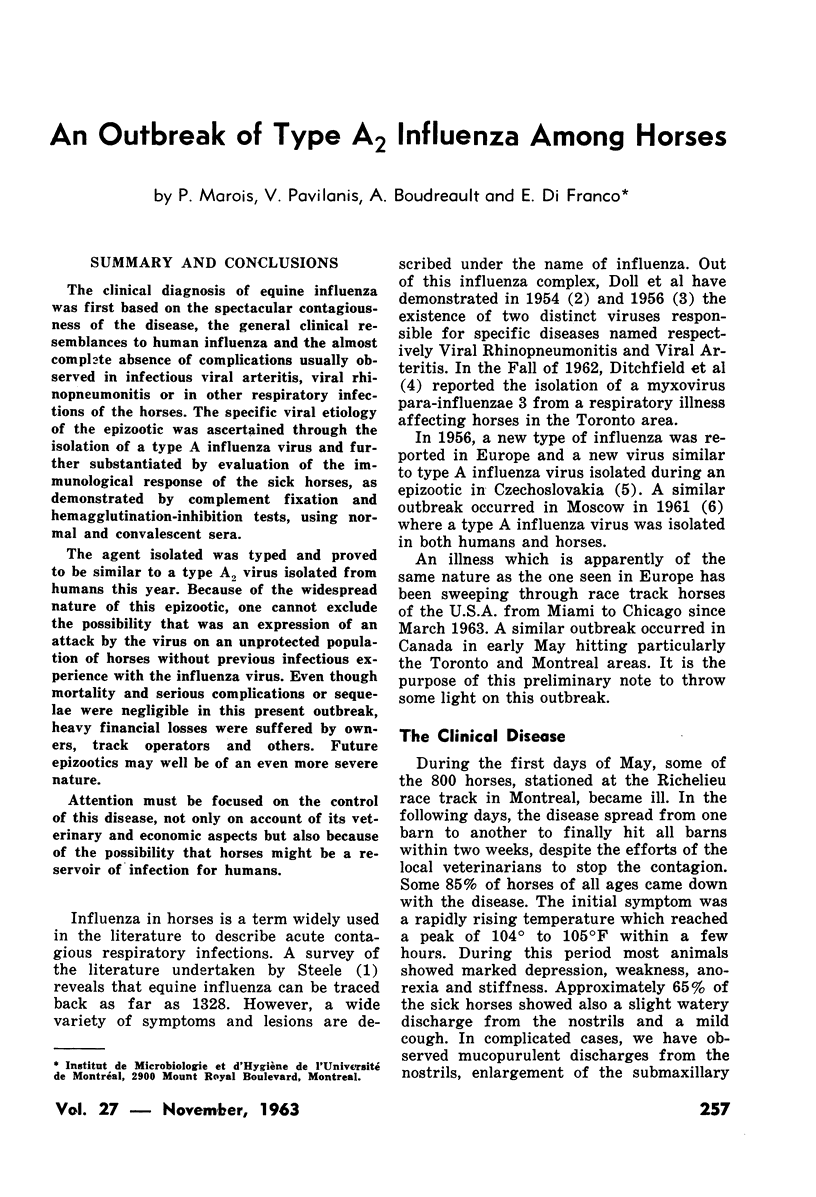Abstract
The clinical diagnosis of equine influenza was first based on the spectacular contagiousness of the disease, the general clinical resemblances to human influenza and the almost complete absence of complications usually observed in infectious viral arteritis, viral rhinopneumonitis or in other respiratory infections of the horses. The specific viral etiology of the epizootic was ascertained through the isolation of a type A influenza virus and further substantiated by evaluation of the immunological response of the sick horses, as demonstrated by complement fixation and hemagglutination-inhibition tests, using normal and convalescent sera.
The agent isolated was typed and proved to be similar to a type A2 virus isolated from humans this year. Because of the widespread nature of this epizootic, one cannot exclude the possibility that was an expression of an attack by the virus on an unprotected population of horses without previous infectious experience with the influenza virus. Even though mortality and serious complications or sequelae were negligible in this present outbreak, heavy financial losses were suffered by owners, track operators and others. Future epizootics may well be of an even more severe nature.
Attention must be focused on the control of this disease, not only on account of its veterinary and economic aspects but also because of the possibility that horses might be a reservoir of infection for humans.
Full text
PDF



Selected References
These references are in PubMed. This may not be the complete list of references from this article.
- BRYANS J. T., CROWE M. E., DOLL E. R., MCCOLLUM W. H. Isolation of a filterable agent causing arteritis of horses and abortion by mares; its differentiation from the equine abortion (influenza) virus. Cornell Vet. 1957 Jan;47(1):3–41. [PubMed] [Google Scholar]
- DOLL E. R., KINTNER J. H. A comparative study of the equine abortion and equine influenza viruses. Cornell Vet. 1954 Jul;44(3):355–367. [PubMed] [Google Scholar]
- Ditchfield J., Zbitnew A., Macpherson L. W. Association of Myxovirus Para Influenzae 3 (RE 55) with Upper Respiratory Infection of Horses. Can Vet J. 1963 Jul;4(7):175–180. [PMC free article] [PubMed] [Google Scholar]
- Hirst G. K. THE AGGLUTINATION OF RED CELLS BY ALLANTOIC FLUID OF CHICK EMBRYOS INFECTED WITH INFLUENZA VIRUS. Science. 1941 Jul 4;94(2427):22–23. doi: 10.1126/science.94.2427.22. [DOI] [PubMed] [Google Scholar]
- TUMOVA B., FISEROVA-SOVINOVA O. Properties of influenza viruses A/Asia/57 and A-equi/Praha/56. I. Agglutination of red blood cells. Bull World Health Organ. 1959;20(2-3):445–454. [PMC free article] [PubMed] [Google Scholar]


